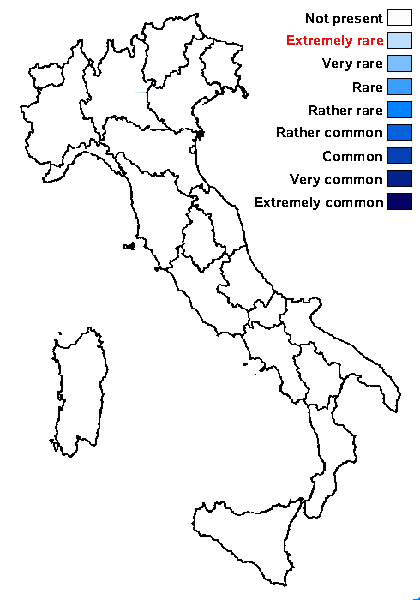Involucropyrenium terrigenum (Zschacke) Breuss
Ann. naturh. Mus. Wien, Ser. B, Bot. Zool., 98, suppl.: 38, 1996. Basionym: Verrucaria terrigena Zschacke - Rabenh. Krypt.-Fl., 2nd ed., 9.1, 1: 260. 1933
Synonyms:
Distribution:
Description: Thallus squamulose to subcrustose and verrucose-areolate, ash-grey, epruinose, c. 0.1 mm thick, closely adpressed, sometimes delimited by a pale prothallus. Squamules 0.4-0.6 mm broad, rounded to crenate, flattened to slightly convex, smooth, contiguous, mostly forming a subcrustose thallus over a black hypothallus; lower surface attached by c. 4 µm thick, pale rhizohyphae. Upper cortex paraplectenchymatous, of small isodiametrical cells, rather thin, poorly differentiated from the algal layer; lower cortex absent. Perithecia black, 0.2-0.3 mm across, developing from the hypothallus and located among the squamules, globose, projecting. Involucrellum extending all around the perithecium, 0.3-0.35 mm wide; exciple dark throughout, of tangentially arranged, elongated cells; hamathecium of periphyses, interascal filaments absent. Asci 8-spored, clavate, with biseriately arranged spores, the wall I-. Ascospores 1-celled, hyaline, broadly ellipsoid to subglobose, thin-walled, 10-12 x 7-8.5 µm. Photobiont chlorococcoid. Spot tests: cortex and medulla K-, C-, KC-, P- UV-. Chemistry: without lichen substances. Note: on acidic soil near and above treeline; very rare and so far only reported from two localities in the Alps (Austria); to be looked for in the Italian Alps.
Growth form: Crustose
Substrata: soil, terricolous mosses, and plant debris
Photobiont: green algae other than Trentepohlia
Reproductive strategy: mainly sexual
Poorly known taxon in need of further study

Predictive model
Growth form: Crustose
Substrata: soil, terricolous mosses, and plant debris
Photobiont: green algae other than Trentepohlia
Reproductive strategy: mainly sexual
Poorly known taxon in need of further study

Predictive model
 Index Fungorum
Index Fungorum
 GBIF
GBIF

